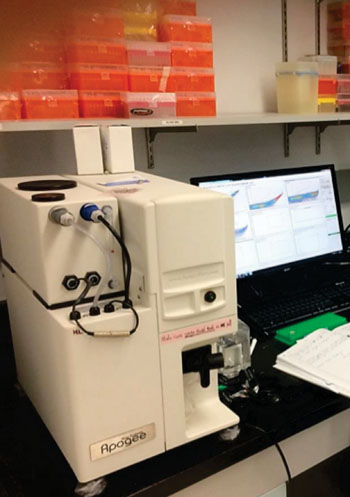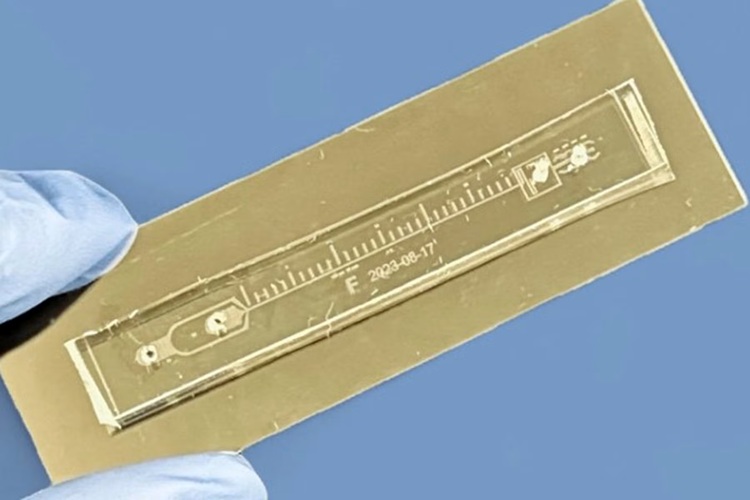Prostate Cancer Detected in Blood Using Flow Cytometry
|
By LabMedica International staff writers Posted on 22 Feb 2016 |

Image: The Apogee Flow Cytometer used for detecting microparticles of prostate cancer (Photo courtesy of Schulich School of Medicine and Dentistry).
Current methods of detecting prostate cancer, such as the prostate-specific antigen (PSA) test and biopsies, have limitations. PSA tests are based on measuring a specific protein released by the prostate gland, but do not provide a definitive diagnosis.
A physical exam and biopsy are needed if PSA levels are elevated; however, even the painful biopsy procedure has a 15% error rate. During biopsies, a painful and invasive procedure, 12 needles are inserted into the rectum, with the hope of extracting material from an area with a tumor.
A team of scientists at the Western University's Schulich School of Medicine and Dentistry (London, ON, Canada) and at Lawson Health Research Institute (London, ON, Canada) have repurposed a machine once used to detect airborne pathogens in the second Gulf War. The machine is now used for fluid biopsies, a noninvasive way to detect prostate microparticles in the blood in a matter of minutes. Microparticles are essentially refuse released by prostate cells that circulate throughout the bloodstream.
The machine was used in the Gulf War, and more commonly to test water purity and the machine uses flow cytometry (Apogee Flow Systems; Hemel Hempstead, UK) to detect microparticles. Flow cytometry measures the specific characteristics of a fluid, such as blood, as it passes through a laser. Most men, who are more than 40 years old, regardless of their health, have detectable levels of prostate microparticles in their bloodstream. The scientists have conducted the first clinical cancer project to correlate the number of microparticles in the blood to the risk of having prostate cancer in that the more microparticles, the higher the risk.
The study provides a more accurate and less invasive testing method for patients suspected of having prostate cancer, and helps to identify patients who are at a higher risk of dying from prostate cancer. Hon Leong, PhD, an assistant professor and team leader, said, “Our findings point to a new direction in how we can better identify patients who actually have prostate cancer. With this test, we can improve the clinical outcomes for patients, reducing costs for unnecessary procedures and reducing errors in diagnosis.”
Related Links:
Western University's Schulich School of Medicine and Dentistry
Lawson Health Research Institute
Apogee Flow Systems
A physical exam and biopsy are needed if PSA levels are elevated; however, even the painful biopsy procedure has a 15% error rate. During biopsies, a painful and invasive procedure, 12 needles are inserted into the rectum, with the hope of extracting material from an area with a tumor.
A team of scientists at the Western University's Schulich School of Medicine and Dentistry (London, ON, Canada) and at Lawson Health Research Institute (London, ON, Canada) have repurposed a machine once used to detect airborne pathogens in the second Gulf War. The machine is now used for fluid biopsies, a noninvasive way to detect prostate microparticles in the blood in a matter of minutes. Microparticles are essentially refuse released by prostate cells that circulate throughout the bloodstream.
The machine was used in the Gulf War, and more commonly to test water purity and the machine uses flow cytometry (Apogee Flow Systems; Hemel Hempstead, UK) to detect microparticles. Flow cytometry measures the specific characteristics of a fluid, such as blood, as it passes through a laser. Most men, who are more than 40 years old, regardless of their health, have detectable levels of prostate microparticles in their bloodstream. The scientists have conducted the first clinical cancer project to correlate the number of microparticles in the blood to the risk of having prostate cancer in that the more microparticles, the higher the risk.
The study provides a more accurate and less invasive testing method for patients suspected of having prostate cancer, and helps to identify patients who are at a higher risk of dying from prostate cancer. Hon Leong, PhD, an assistant professor and team leader, said, “Our findings point to a new direction in how we can better identify patients who actually have prostate cancer. With this test, we can improve the clinical outcomes for patients, reducing costs for unnecessary procedures and reducing errors in diagnosis.”
Related Links:
Western University's Schulich School of Medicine and Dentistry
Lawson Health Research Institute
Apogee Flow Systems
Latest Technology News
- AI Saliva Sensor Enables Early Detection of Head and Neck Cancer
- AI-Powered Biosensor Technology to Enable Breath Test for Lung Cancer Detection
- AI Model Achieves Breakthrough Accuracy in Ovarian Cancer Detection
- Portable Biosensor Diagnoses Psychiatric Disorders Using Saliva Samples
- Cell-Sorting Device Uses Electromagnetic Levitation to Precisely Direct Cell Movement

- Embedded GPU Platform Enables Rapid Blood Profiling for POC Diagnostics
- Viral Biosensor Test Simultaneously Detects Hepatitis and HIV
- Acoustofluidic Device to Transform Point-Of-Care sEV-Based Diagnostics
- AI Algorithm Assesses Progressive Decline in Kidney Function
- Taste-Based Influenza Test Could Replace Nasal Swabs with Chewing Gum
- 3D Micro-Printed Sensors to Advance On-Chip Biosensing for Early Disease Detection
Channels
Clinical Chemistry
view channel
Chemical Imaging Probe Could Track and Treat Prostate Cancer
Prostate cancer remains a leading cause of illness and death among men, with many patients eventually developing resistance to standard hormone-blocking therapies. These drugs often lose effectiveness... Read more
Mismatch Between Two Common Kidney Function Tests Indicates Serious Health Problems
Creatinine has long been the standard for measuring kidney filtration, while cystatin C — a protein produced by all human cells — has been recommended as a complementary marker because it is influenced... Read moreMolecular Diagnostics
view channel
New Genetic Test Enables Faster Diagnosis of Rare Diseases
Rare disease diagnosis often involves a long and uncertain search for the underlying genetic cause. Traditional testing requires multiple separate analyses, although many patients remain without answers.... Read more
Urine Test Detects Inherited Neuropathy Missed by Genetic Screening
Sorbitol dehydrogenase (SORD)-related neuropathy is one of the most common inherited nerve disorders, yet diagnosis often lags because current genetic screens frequently miss the causal gene.... Read moreHematology
view channel
Platelet Activity Blood Test in Middle Age Could Identify Early Alzheimer’s Risk
Early detection of Alzheimer’s disease remains one of the biggest unmet needs in neurology, particularly because the biological changes underlying the disorder begin decades before memory symptoms appear.... Read more
Microvesicles Measurement Could Detect Vascular Injury in Sickle Cell Disease Patients
Assessing disease severity in sickle cell disease (SCD) remains challenging, especially when trying to predict hemolysis, vascular injury, and risk of complications such as vaso-occlusive crises.... Read more
ADLM’s New Coagulation Testing Guidance to Improve Care for Patients on Blood Thinners
Direct oral anticoagulants (DOACs) are one of the most common types of blood thinners. Patients take them to prevent a host of complications that could arise from blood clotting, including stroke, deep... Read moreImmunology
view channel
Chip Captures Cancer Cells from Blood to Help Select Right Breast Cancer Treatment
Ductal carcinoma in situ (DCIS) accounts for about a quarter of all breast cancer cases and generally carries a good prognosis. This non-invasive form of the disease may or may not become life-threatening.... Read more
Blood-Based Liquid Biopsy Model Analyzes Immunotherapy Effectiveness
Immunotherapy has revolutionized cancer care by harnessing the immune system to fight tumors, yet predicting who will benefit remains a major challenge. Many patients undergo costly and taxing treatment... Read moreMicrobiology
view channel
Rapid Assay Identifies Bloodstream Infection Pathogens Directly from Patient Samples
Bloodstream infections in sepsis progress quickly and demand rapid, precise diagnosis. Current blood-culture methods often take one to five days to identify the pathogen, leaving clinicians to treat blindly... Read more
Blood-Based Molecular Signatures to Enable Rapid EPTB Diagnosis
Extrapulmonary tuberculosis (EPTB) remains difficult to diagnose and treat because it spreads beyond the lungs and lacks easily accessible biomarkers. Despite TB infecting 10 million people yearly, the... Read more
15-Minute Blood Test Diagnoses Life-Threatening Infections in Children
Distinguishing minor childhood illnesses from potentially life-threatening infections such as sepsis or meningitis remains a major challenge in emergency care. Traditional tests can take hours, leaving... Read more
High-Throughput Enteric Panels Detect Multiple GI Bacterial Infections from Single Stool Swab Sample
Gastrointestinal (GI) infections are among the most common causes of illness worldwide, leading to over 1.7 million deaths annually and placing a heavy burden on healthcare systems. Conventional diagnostic... Read morePathology
view channel
Blood Test and Sputum Analysis Predict Acute COPD Exacerbation
Chronic obstructive pulmonary disease (COPD) remains a major contributor to global illness, largely driven by cigarette smoking and marked by irreversible lung damage. Acute exacerbations can accelerate... Read more
AI Tool to Transform Skin Cancer Detection with Near-Perfect Accuracy
Melanoma continues to be one of the most difficult skin cancers to diagnose because it often resembles harmless moles or benign lesions. Traditional AI tools depend heavily on dermoscopic images alone,... Read more
Unique Immune Signatures Distinguish Rare Autoimmune Condition from Multiple Sclerosis
Myelin oligodendrocyte glycoprotein antibody–associated disease (MOGAD) is a rare autoimmune disorder in which the immune system attacks the myelin sheath in the central nervous system. Although symptoms... Read moreIndustry
view channel
Abbott Acquires Cancer-Screening Company Exact Sciences
Abbott (Abbott Park, IL, USA) has entered into a definitive agreement to acquire Exact Sciences (Madison, WI, USA), enabling it to enter and lead in fast-growing cancer diagnostics segments.... Read more






















